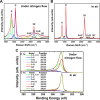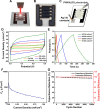Biocompatible Parylene-C Laser-Induced Graphene Electrodes for Microsupercapacitor Applications
- PMID: 36209418
- PMCID: PMC9585513
- DOI: 10.1021/acsami.2c09667
Biocompatible Parylene-C Laser-Induced Graphene Electrodes for Microsupercapacitor Applications
Abstract
Laser irradiation of polymeric materials has drawn great attention as a fast, simple, and cost-effective method for the formation of porous graphene films that can be subsequently fabricated into low-cost and flexible electronic and energy-storage devices. In this work, we report a systematic study of the formation of laser-induced graphene (LIG) with sheet resistances as low as 9.4 Ω/sq on parylene-C ultrathin membranes under a CO2 infrared laser. Raman analysis proved the formation of the multilayered graphenic material, with ID/IG and I2D/IG peak ratios of 0.42 and 0.65, respectively. As a proof of concept, parylene-C LIG was used as the electrode material for the fabrication of ultrathin, solid-state microsupercapacitors (MSCs) via a one-step, scalable, and cost-effective approach, aiming at future flexible and wearable applications. The produced LIG-MSC on parylene-C exhibited good electrochemical behavior, with a specific capacitance of 1.66 mF/cm2 and an excellent cycling stability of 96% after 10 000 cycles (0.5 mA/cm2). This work allows one to further extend the knowledge in LIG processes, widening the group of precursor materials as well as promoting future applications. Furthermore, it reinforces the potential of parylene-C as a key material for next-generation biocompatible and flexible electronic devices.
Keywords: biocompatible devices; flexible electronic devices; laser-induced graphene; microsupercapacitors; parylene-C; scalable production methods.
Conflict of interest statement
The authors declare no competing financial interest.
Figures





References
-
- Palchoudhury S.; Ramasamy K.; Gupta R. K.; Gupta A. Flexible Supercapacitors: A Materials Perspective. Front. Mater. 2019, 5, 8310.3389/fmats.2018.00083. - DOI
-
- Muralee Gopi C. V. V.; Vinodh R.; Sambasivam S.; Obaidat I. M.; Kim H. J. Recent Progress of Advanced Energy Storage Materials for Flexible and Wearable Supercapacitor: From Design and Development to Applications. J. Energy Storage 2020, 27, 10103510.1016/J.EST.2019.101035. - DOI
-
- Coelho J.; Kremer M. P.; Pinilla S.; Nicolosi V. An Outlook on Printed Microsupercapacitors: Technology Status, Remaining Challenges, and Opportunities. Curr. Opin. Electrochem. 2020, 21, 69–75. 10.1016/j.coelec.2019.12.004. - DOI
LinkOut - more resources
Full Text Sources
Research Materials

